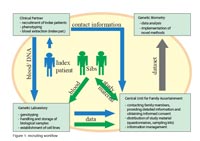Introduction
Complex diseases such as Parkinson’s and Alzheimer’s disease have a higher prevalence than monogenic disorders in the general population. They cause a higher burden of illness and are thus of high socioeconomic relevance. Studies on complex diseases tend to be rather complex themselves. They are frequently multicenter, joining up different medical institutions and clinical researchers with geneticists and epidemiologists.
In the studies of complex diseases, large samples of patients are needed which can be attained by either pooling existing biosample collections or de novo recruitment. Existing collections often are not sufficiently phenotyped, leaving prospective recruitment as the better option. Prospective recruitment is often the only viable way to get thoroughly phenotyped samples with detailed pedigree structure. The organisation of comprehensive field work logistics is therefore crucial for high quality recruitment, rigorous phenotype assessment and high-throughput genotyping.
Results/Project Status
The organisational effort and logistical challenge for nationwide recruitment of patients and their families is quite big. Therefore we have established a recruitment unit, which is offered to partners within the NGFN. In NGFN 1 a dedicated family ascertainment system has been set up. This internet based system that assures a smooth monitoring of the recruitment process and a control over the phenotype database has been steadily improved within NGFN-2.
In consultation with our clinical partners we conduct:
- Field work-logistics
- Modelling work flow between the partners and continuous quality control.
- Development of questionnaires and study material.
- Ethical and continuous privacy counselling.
- Training of staff.
- Recruiting of study population
- Recruitment of index patients and family members. Raising medical history and investigating the pedigrees of multiplex families.
- Coordination of collection of specimen through GPs.
- Increased proband catchment through e.g. media campaigns (newspaper, radio, internet).
- Coordinate patients visits at distributed study centres.
- Data management
- Real time study management and document tracking.
- Detailed access control.
- Document data entry.
- Integration of phenotypic and genotypic data, including tests of plausibility.
To distribute information between partners more efficiently, an online system for recruiting fieldwork with remote data entry capabilities has been developed. Early quality control avoids later problems with inconsistent or incomplete data, e.g. questionnaire completeness is checked and noted immediately. A high quality of primary data is essential for valid analysis and interpretation and should encompass:
- phenotype verification
- awareness of heterogeneity in multicenter studies
- comprehensive family history
- study handbook with standard operational procedures of all partners involved (clinic, lab, field-work office)
- regular controlling and adherence to study protocols
- real-time feedback of quality improvements into all levels of the study

In our studies, careful analysis of the various work processes created a new “virtual study center” with distributed structures but a shared, real-time information pool as opposed to one centrally located administrative body with paper notes. The electronic documentation system of our virtual study center allows instant access to all important recruitment parameters and facilitates cross-institutional information-exchange. It includes “static” information such as consent forms or questionnaires as well as dynamic information such as number of recruits and completeness of families.
Our integrated study management system for remote data entry is based on open standards and runs on a variety of hardware platforms. Our clinical partners and service labs can access and update relevant information from any web browser. The system is online since January 2002 and serves as workflow interface for clinicians, geneticists and epidemiologists.
Within NGFN 1+2 we recruit patients for two projects in the network of “Diseases of the Nervous System”. So far 562 participants with Parkinson's disease have been recruited. 171 sib-pairs/families, including 36 extended families with at least two affected members (up to 24 participants) are available. For Alzheimer's disease 938 participants corresponding to 314 sib-pairs/families including 40 families with multiple patients (up to 22 participant members) have been recruited. The medical history was investigated and pedigrees of the multiplex families were described. Detailed phenotype data (questionnaires, medical reports, memorytests) and DNA are available to be integrated in the NGFN studies to identify genetic risk factors of Parkinson´s Disease (PI Thomas Gasser, Tübingen) and disease genes of Alzheimers Disease (PI Matthias Riemenschneider, München).
Outlook
The recruitment within the NGFN projects will be continued. In principle, the structure of the GSF recruitment center can be used for studies in other fields. Meanwhile, applications for cardiovascular families and lung cancer families (outside of NGFN) have been realized.


